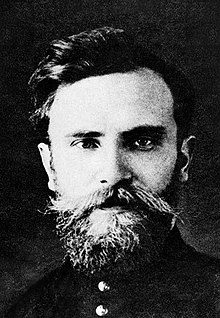Konstantin Rodzaevsky
Konstantin Rodzaevsky | |
|---|---|
 | |
| Personal details | |
| Born | Konstantin Vladimirovich Rodzaevsky 11 August 1907 Blagoveshchensk, Russian Empire |
| Died | 30 August 1946 (aged 39) Moscow, Russian SFSR, Soviet Union |
| Political party | Russian Fascist Party |
| Profession | Lawyer |
| Signature |  |
Konstantin Vladimirovich Rodzaevsky (Russian: Константи́н Влади́мирович Родзае́вский; 11 August 1907 – 30 August 1946) was the leader of the Russian Fascist Party, which he led in exile from Manchuria. Rodzaevsky was also the chief editor of the RFP paper "Nash Put'".
Far Eastern Fascism
Born in Blagoveshchensk (across the Amur from China) in a family of the Siberian middle-class, he fled the Soviet Union for Manchuria in 1925. In Harbin, Rodzaevsky entered the law academy and joined the Russian Fascist Organization. On May 26, 1931, he became the Secretary General of the newly created Russian Fascist Party; in 1934 the Party amalgamated with the Russian Fascist Organization of Anastasy Vonsyatsky, Rodzaevsky becoming its leader. He modeled himself on Benito Mussolini, and also used the Swastika as one of the symbols of the movement.
Rodzaevsky collected around himself personally selected bodyguards, and used symbolism of the former Russian Empire along with Russian nationalist symbols; like the Italian Blackshirts, the Russian Fascists wore black uniforms with black crossed belts; they were armed with weapons obtained from Japan's Imperial Japanese Army. They created an international organization of White émigrés with a central office in Harbin, the "Russian Far East Moscow", and links in twenty-six nations around the world. The most important of these international posts was in New York City.
Manchukuo

Rodzaevsky had around 12,000 followers in Manchukuo. During the 2,600th anniversary of the founding of the Empire of Japan, Rodzaevsky, with a select group of people, paid his respects to Emperor Hirohito at the official celebration in the region.
The fascists installed a great swastika of neon light at their branch in Manzhouli (Manchouli), at least 3 km from the Soviet border. It was kept on all day and night to provide a show of power against the Soviet government. Rodzaevsky awaited the day when, leaving these signs on the Russian border, he would lead the White Anti-Soviet forces, joining White General Kislitsin and Japanese forces, into battle to "liberate the people of Russia from Soviet rule". Their main military acts involved the training of Asano Detachment, the all ethnic-Russian special forces in the Kwantung Army, organized for carrying out sabotage against Soviet forces in case of any Japanese invasion of Siberia and Russian Far East areas; Japan was apparently interested in creating a White Russian state in Outer Manchuria.
World War II and execution
During World War II, Rodzaevsky tried to launch an open struggle against Bolshevism, but Japanese authorities limited the RFP’s activities to acts of sabotage in the Soviet Union. A notorious anti-Semite, Rodzaevsky published numerous articles in the party newspapers Our way and The Nation; he was also the author of the brochure "Judas’ End"[1] and the book "Contemporary Judaisation of the World or the Jewish Question in the 20th Century".[2]
At the end of the war, perhaps as a desperate attempt to avoid execution in case that he would be captured by the advancing Red Army, Rodzaevsky began to state that the Soviet regime under Joseph Stalin was evolving into a nationalist one. He gave himself up to Soviet authorities in Harbin in 1945, with a letter that shows striking similarities with the doctrines of National Bolshevism:
I issued a call for an unknown leader, ... capable of overturning the Jewish government and creating a new Russia. I failed to see that, by the will of fate, of his own genius, and of millions of toilers, Comrade J.V. Stalin, the leader of the peoples, had become this unknown leader
He returned to Russia, where he was promised freedom and a job in one of the Soviet newspapers. Instead, he was arrested (along with fellow party-member Lev Okhotin), tried, and sentenced to be shot. He was executed in a Lubyanka prison cellar.
In 2001, a book by Rodzaevsky, Zaveshchanie russkogo fashista ("The Last Will of a Russian fascist"), was published in Russia.
Notes
- The Russian Fascists: Tragedy and Farce in Exile, 1925-1945 by John J. Stephan ISBN 0-06-014099-2
- К. В. Родзаевский. Завещание Русского фашиста. М., ФЭРИ-В, 2001 ISBN 5-94138-010-0
- А.В. Окороков. Фашизм и русская эмиграция (1920-1945 гг.). М., Руссаки, 2002 ISBN 5-93347-063-5
- Knútr Benoit: Konstantin Rodzaevsky. Dict, 2012, ISBN 978-6-13841624-1
External links
References
- ^ Judas End Archived 2014-03-04 at the Wayback Machine
- ^ Contemporary Judaisation of the World or the Jewish Question in the 20th Century Archived 2014-03-04 at the Wayback Machine
- 1907 births
- 1946 deaths
- People from Blagoveshchensk
- People from Amur Oblast (Russian Empire)
- Members of the Russian Fascist Party
- Antisemitism in Russia
- Russian anti-communists
- White movement people
- White Russian emigrants to China
- People of Manchukuo
- People executed by the Soviet Union by firearm
- People who emigrated to escape Bolshevism
- Russian nationalists
- Russian fascists
- Executed Russian people
- Executed people from Amur Oblast
